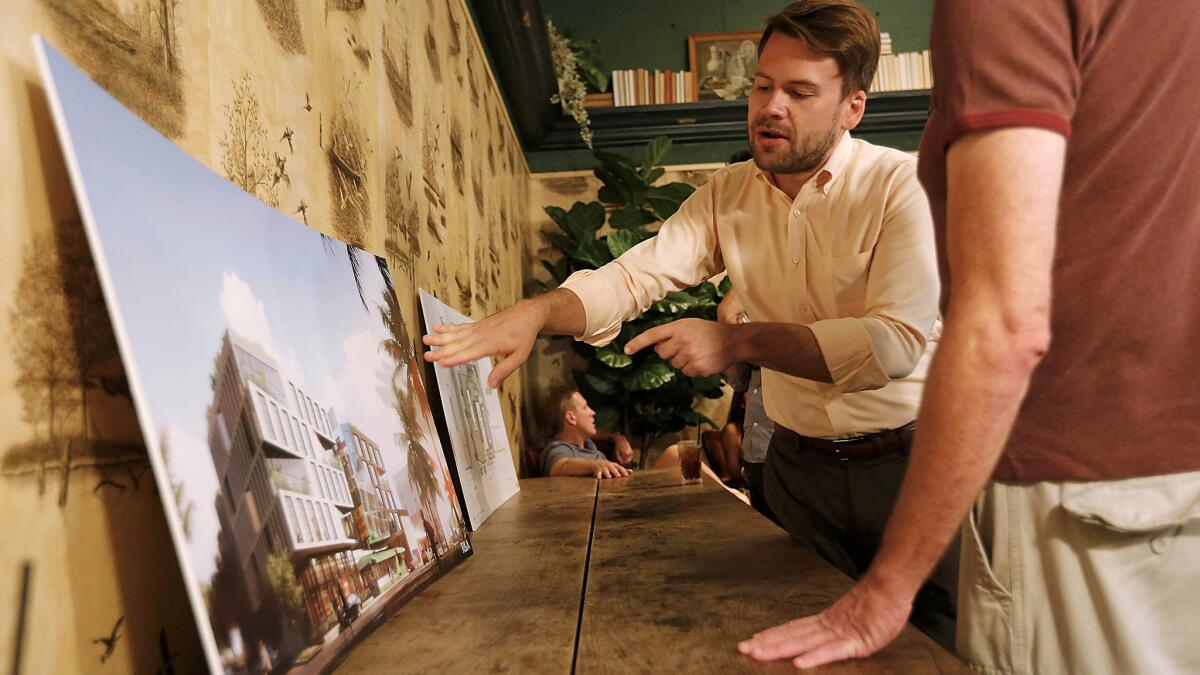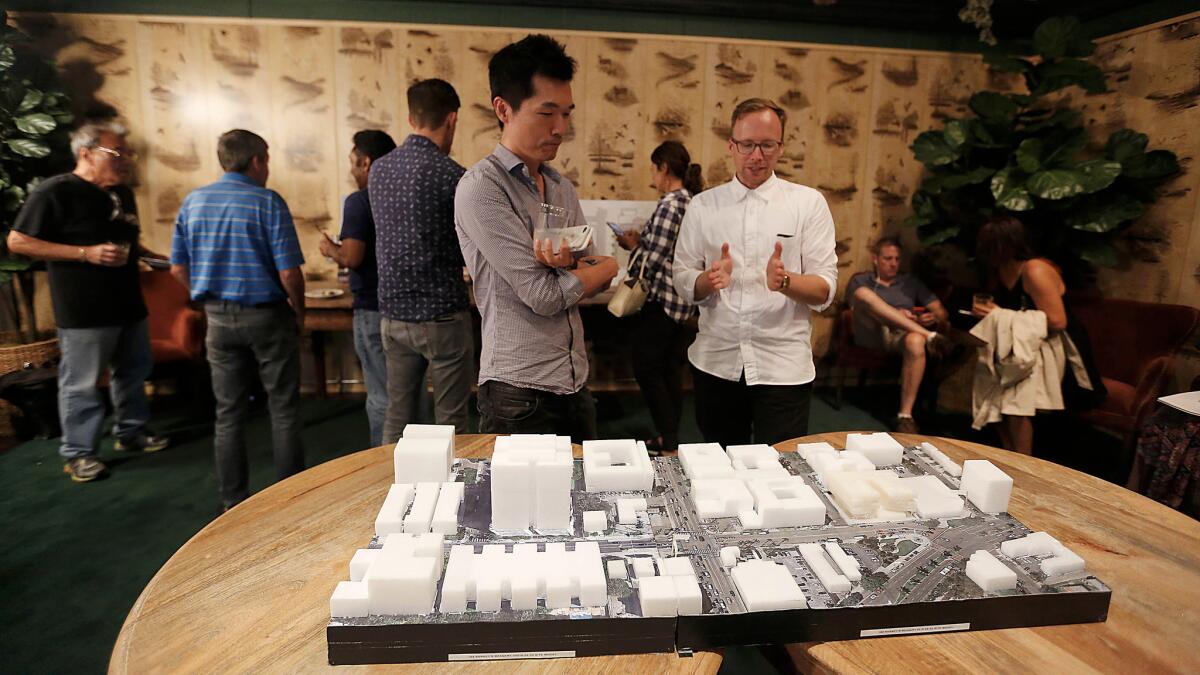Barney’s Beanery has a history of hostility toward gays. But West Hollywood wants to save it anyway
- Share via
Barney’s Beanery has a complicated history in West Hollywood.
The greasy spoon with its multicolored booths and license plates on the walls was a legendary hangout for rockers and movie stars — the place where Janis Joplin is said to have had her last drink before she died, where Jim Morrison was a rowdy regular and where Quentin Tarantino has a favorite table.
The gritty roadhouse also has long exasperated West Hollywood’s large gay community. For years, a sign hung over the bar blaring “Fagots Stay Out” in big, bold letters, and a former owner sold matchbooks with the same misspelled slogan.

Now, with a group of developers and the restaurant’s owners proposing a new five-story hotel for the Barney’s Beanery site, many in West Hollywood are worried about the future of the 89-year-old restaurant — whether they love or hate the place.
The proposal — which is in its early stages — would see Barney’s entirely disassembled, stored offsite during construction and later rebuilt in the same spot at the intersection of Holloway Drive and Santa Monica Boulevard.
A 113-room hotel would be built behind and around it, replacing a surface parking lot and a sushi restaurant. There would be 244 underground parking spaces.
“I think Barney’s is the greatest thing in the world, and I’d never do anything to destroy it,” said David Houston, who has co-owned the restaurant since 1999. “It’s still Barney’s, but more.”
The proposal underscores a growing exasperation among West Hollywood residents over the rapid development of their 1.9-square-mile city — especially the number of new hotels.
As two women who live on Hacienda Place near Barney’s left a community meeting hosted by the developers last week, they complained that the project would bring too much traffic to a congested area that already has a hotel and a motel on the same block.
“I just don’t understand the need for it. Why do we need another bar-restaurant-hotel?” one woman asked. “Will people even come to it?”
Another resident lamented the loss of the neighborhood bar where he has watched football games for more than a decade, a place where he said anyone, in fact, is welcome.
West Hollywood Mayor Lauren Meister said she has not yet formed an opinion on the Barney’s Beanery project but that the number of hotels both under construction and under review by the city has residents concerned about too much growth.

“West Hollywood is such a vibrant place that developers and hotels want to be here, and, let’s face it, hotels offer the city good revenue,” she said. “It’s attractive on both sides, but we have to consider other factors when we plan.… A lot of this commercial development is focused on hotels, and you have to have other industry to have some economic diversity.”
A recent community survey showed that 54% of West Hollywood residents said growth and development were a serious problem, 87% said traffic and congestion were a serious problem, and 79% said the lack of parking was a serious problem.
A West Hollywood hotel market study presented at the City Council meeting last week showed that the number of new hotels under construction, approved and under review have a combined 1,229 hotel rooms — equal to 60% of the current rooms in the city.
“The addition of even a portion of these rooms would represent a significant increase,” the report states. If all of the projects — including those under review but not yet approved by the city — were to be built, the city’s hotel occupancy rate, which is projected at 82% this year, would potentially fall to 68% by 2020 and not return to 80% until 2026, the report states.
The report does not include the Barney’s Beanery project. The developers — a joint venture between the restaurant’s owners and VE Equities — submitted a project application to the city in August, a spokesman for the project said.
Barney’s Beanery has been identified as a potential cultural resource but has not yet been officially reviewed as such, said Joshua Schare, a city spokesman.
Such a designation would not necessarily stop construction. Irv’s Burgers, a 63-year-old Santa Monica Boulevard burger stand, was named an official city cultural resource after residents formed what they called the “Burger Brigade” to save it. But in 2013, facing rising rents and other problems, Irv’s was forced to relocate and a new restaurant was built on the property, with the original burger stand being incorporated into it.
The original Barney’s — now one of a chain of restaurants — was built in 1927 and is one of the Los Angeles region’s oldest restaurants. It was surrounded by a large poinsettia field and situated along the then newly built Route 66.
The restaurant drew generations of stars, like Clark Gable, Rita Hayworth, Marlon Brando and Jack Nicholson. After a night of hard drinking in the 1960s, Jim Morrison of the Doors is said to have stood up and urinated on the long wooden bar. The bar’s owners put a plaque there in his honor.
The anti-gay sign hung above the bar for years. The restaurant’s founder, World War I veteran John “Barney” Anthony, is said to have put it up after police in the 1940s raided his restaurant in connection with then-illegal homosexual activity.
When West Hollywood became a city in 1984, one of the first acts of the City Council — the first in the nation with a gay majority — was to pass an anti-discrimination ordinance. The city threatened the then-owner of Barney’s, Irwin Held, with a $500-a-day fine over the sign. Despite pickets and protests, Held initially refused but in1985 reluctantly agreed to let the city’s first mayor, a lesbian, remove the sign and to stop selling matchbooks with the slogan.
Mayor Meister called Barney’s “part of our history, the good, the bad and the ugly.”
The proposed development on the Barney’s site would include a pool deck, restaurant, live music space and recording studio. According to the developers, it would take more than two years to build. Developers said Barney’s would have to be disassembled during construction in part because of the building of the underground parking but that it would be entirely preserved and rebuilt.
“Because of its place on Route 66 and the significance of that, Barney’s has a lot of different layers of meaning,” said Trudi Sandmeier, director of graduate heritage conservation programs at the USC School of Architecture. “Even with the mixed history that goes along with it, the cultural history … makes it a landmark.”
She lamented “the idea of taking it apart and putting it back together again” because doing so is difficult and expensive with old buildings that might not be up to current building codes and that might have underlying structural issues.
“Once you take something apart, the odds of it getting put back together in any way that’s meaningful are very thin,” Sandmeier said.
The developers say that preserving Barney’s is a top priority and that they will continue a running dialogue with neighbors for what is likely to be a years-long project review process.
Project spokesman Steven Afriat said in a statement that the development “is designed to both celebrate our community’s history and give the Barney’s Beanery structure and the Holloway corridor new life.”
Twitter: @haileybranson
ALSO
Donald Trump has some Latinos so unnerved, they’re turning to the supernatural for help
How one reading advocate hopes to change the lives of juvenile hall detainees through a library
Summer in the fall: Triple-digit temperatures, Santa Ana winds keep Southern California hot
More to Read
Sign up for Essential California
The most important California stories and recommendations in your inbox every morning.
You may occasionally receive promotional content from the Los Angeles Times.











